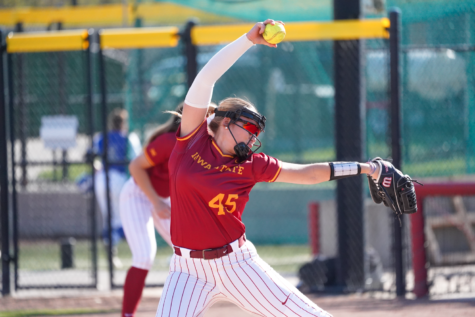3-point line to move back in ’08 season
June 12, 2007
ISU forward Wesley Johnson doesn’t look where he shoots. Starting this summer, he’ll be paying closer attention to where he spots up for 3-pointers after a decision made by the NCAA in May that will move the 3-point line back a foot for the 2008-09 season.
“As far as them moving it back, it won’t affect my shot,” said Johnson, who shot 29 percent from 3-point range last season.
What it will affect is the overall flow of the game. Larry Keating, the senior associate athletic director at Kansas and chairman of the NCAA men’s basketball rules committee, said he hopes moving back the lines will open the game more and lower shooting percentages.
“As a fan you may want to see everybody bombing threes and shooting 50 percent from 3-point range, but when you look at the whole game you don’t want to get to the point where it’s out of control and the offense has significantly more advantage than the defense,” Keating said.
The changes, which will move the 3-point line back to 20 feet 9 inches, won’t go into effect for another year. Most players don’t see the change having a huge impact on their play.
“We draw our plays and try to get certain guys open shots for threes and we really don’t look down to see where our feet are,” said sophomore guard Brock Jacobson. “Sometimes I’m sure over half of the 3-point shots we shoot anyways are probably a foot behind the line anyways.”
In fact, some players like Jacobson are looking forward to the change. While Keating said he hopes 3-point shooting percentages will go down, Jacobson thinks that, while defenses are adjusting to the new post play, he’ll get more open looks.
“It’s going to spread the offense out a bit and give a post player like Jiri [Hubalek] and the other post players we have more open area to be able to go to work and it’ll give us guards out on the wing a little more space between each other,” Jacobson said.
But not everyone was as excited about the change as Jacobson. A number of coaches voiced their concerns over the adjustment, including ISU men’s coach Greg McDermott.
“Maybe I’m old school, but if everything is going fine, why is there a need to change?” McDermott said. “I thought the game was as popular as it’s ever been.
“There were some great college basketball games during the course of the season last year, and if that’s the case, I don’t understand the reason to make the change.”
McDermott said that while the change may discourage average shooters from taking a 3-pointer in the future, the move back shouldn’t have much of an effect on his team’s preparation. With the team having already practiced behind the line during the course of the year and played in several exhibition games with the expanded line, McDermott said most of his players are already shooting from beyond the current arc.
“Most of the time your players aren’t standing right on the 3-point line or right off the line anyways,” he said. “You catch the ball in your comfort area and take what the defense gives you and I think that will continue to be the case.”
For downtown shooters like Johnson, however, it will be an opportunity to show fans just how good a shooter he is.
“Moving it back will show people my range and how far I can shoot it,” said Johnson, who averaged 12.3 points per game and hit 32 3-pointers last season. “I’m real excited about it.”
Iowa State’s top 3-point shooters last season
Mike Taylor: 77-214, 36 percent
Wesley Johnson: 32-109, 29 percent
Rahshon Clark: 16-64, 25 percent
Brock Jacobson: 10-38, 26 percent
TEAM: 203-627, 32 percent
Struggles from the arc
– Iowa State ranked 11th in 3-point field goal percentages (.324) in the Big 12 last season, ahead of only Colorado.
-Iowa State ranked 253rd of 325 Division I teams in 3-point field goal percentage.
NBA 3-point line
While the college 3-point line is uniformly 19 feet 9 inches from the hoop, the NBA’s 3-point line actually varies in distance along its length. Running from the baselines, 3 feet from the sidelines, are two parallel lines. Along these lines the distance grows from 22 feet at the baseline to 23 feet 9 inches at the point where the line begins to arc. The line is this way because if it was a fixed distance as it is along the arc, there wouldn’t be enough room to stand along the sidelines.
















